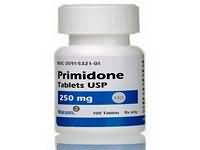CLINICAL USE
Anti-epileptic agent Also used for essential tremor
DOSE IN NORMAL RENAL FUNCTION
Epilepsy: 500 mg–1.5 g daily in 2 divided dosesEssential tremor: 62.5–750 mg daily
PHARMACOKINETICS
DOSE IN RENAL IMPAIRMENT
GFR (mL/MIN)
DOSE IN PATIENTS UNDERGOING RENAL REPLACEMENT THERAPIES
IMPORTANT DRUG INTERACTIONS
Potentially hazardous interactions with other drugs
ADMINISTRATION
Reconstition
–
Route
Oral
Rate of Administration
–
Comments
–.PriMidonE 605
OTHER INFORMATION
Plasma concentrations of 5–12 mcg/L (23– 55 µmol/L) have been loosely correlated with optimum responsePartially converted to phenobarbital and phenylethylmalonamide with long half-lives (metabolites may accumulate in renal impairment)May cause excessive sedation and osteomalacia.
